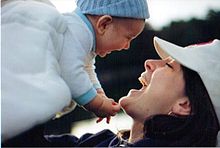
Back افتقاد الأمومة Arabic Citová deprivace Czech Privación materna Spanish محرومیت مادرانه Persian Carence affective French Sindrome da deprivazione materna Italian 愛情遮断症候群 Japanese Когнитивті депривация Kazakh 모성 결핍 Korean له مور نه محرومیت Pashto/Pushto

Maternal deprivation is a scientific term summarising the early work of psychiatrist and psychoanalyst John Bowlby on the effects of separating infants and young children from their mother (or primary caregiver).[1] Although the effect of loss of the mother on the developing child had been considered earlier by Freud and other theorists, Bowlby's work on delinquent and affectionless children and the effects of hospital and institutional care led to his being commissioned to write the World Health Organization's report on the mental health of homeless children in post-war Europe whilst he was head of the Department for Children and Parents at the Tavistock Clinic in London after World War II.[2] The result was the monograph Maternal Care and Mental Health published in 1951, which sets out the maternal deprivation hypothesis.[3]
Bowlby drew together such empirical evidence as existed at the time from across Europe and the US, including Spitz (1946) and Goldfarb (1943, 1945). His main conclusions, that "the infant and young child should experience a warm, intimate, and continuous relationship with his mother (or permanent mother substitute) in which both find satisfaction and enjoyment" and that not to do so might have significant and irreversible mental health consequences, were both controversial and influential.[4] The monograph was published in 14 different languages and sold over 400,000 copies in the English version alone. Bowlby's work went beyond the suggestions of Otto Rank and Ian Suttie that mothering care was essential for development, and focused on the potential outcomes for children deprived of such care.
The 1951 WHO publication was highly influential in causing widespread changes in the practices and prevalence of institutional care for infants and children, and in changing practices relating to the stays of small children in hospitals so that parents were allowed more frequent and longer visits. Although the monograph was primarily concerned with the removal of children from their homes it was also used for political purposes to discourage women from working and leaving their children in daycare by governments concerned about maximising employment for returned and returning servicemen. The publication was also highly controversial with, amongst others, psychoanalystsf, psychologists and learning theorists, and sparked significant debate and research on the issue of children's early relationships.
The limited empirical data and lack of comprehensive theory to account for the conclusions in Maternal Care and Mental Health led to the subsequent formulation of attachment theory by Bowlby.[5] Following the publication of Maternal Care and Mental Health Bowlby sought new understanding from such fields as evolutionary biology, ethology, developmental psychology, cognitive science and control systems theory and drew upon them to formulate the innovative proposition that the mechanisms underlying an infant's ties emerged as a result of evolutionary pressure.[6] Bowlby claimed to have made good the "deficiencies of the data and the lack of theory to link alleged cause and effect" in Maternal Care and Mental Health in his later work Attachment and Loss published between 1969 and 1980.[7]
Although the central tenet of maternal deprivation theory—that children's experiences of interpersonal relationships are crucial to their psychological development and that the formation of an ongoing relationship with the child is as important a part of parenting as the provision of experiences, discipline and child care—has become generally accepted, "maternal deprivation" as a discrete syndrome is not a concept that is much in current use other than in relation to severe deprivation as in "failure to thrive". In the area of early relationships it has largely been superseded by attachment theory and other theories relating to even earlier infant–parent interactions. As a concept, parental deficiencies are seen as a vulnerability factor for, rather than a direct cause of, later difficulties. In relation to institutional care there has been a great deal of subsequent research on the individual elements of privation, deprivation, understimulation and deficiencies that may arise from institutional care.
- ^ Holmes 1993, p. 221
- ^ Bretherton, I. (1992). "The Origins of Attachment Theory: John Bowlby and Mary Ainsworth". Developmental Psychology. 28 (5): 759–775. doi:10.1037/0012-1649.28.5.759. S2CID 3964292.
- ^ Bowlby, John (1995) [1951]. Maternal Care and Mental Health. Master Work Series. Vol. 2 (Softcover ed.). Northvale, NJ: Jason Aronson. pp. 355–533. ISBN 978-1-56821-757-4. PMC 2554008. PMID 14821768.
{{cite book}}:|journal=ignored (help) - ^ Bowlby 1995, p. 11
- ^ Bowlby 1988, p. 24
- ^ Cassidy, J. (1999). "The Nature of the Child's Ties". In Cassidy, J.; Shaver, P.R. (eds.). Handbook of Attachment: Theory, Research and Clinical Applications. Guilford press. ISBN 978-1-57230-826-8.
- ^ Bowlby, J. (1986). "Maternal Care and Mental Health" (PDF). Bulletin of the World Health Organization. Citation Classic. 3 (3): 355–533. PMC 2554008. PMID 14821768.
© MMXXIII Rich X Search. We shall prevail. All rights reserved. Rich X Search